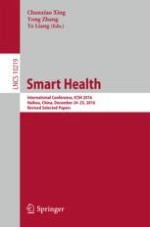2017 | Buch
Smart Health
International Conference, ICSH 2016, Haikou, China, December 24-25, 2016, Revised Selected Papers
herausgegeben von: Chunxiao Xing, Yong Zhang, Ye Liang
Verlag: Springer International Publishing
Buchreihe : Lecture Notes in Computer Science
